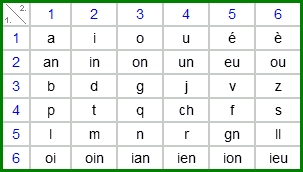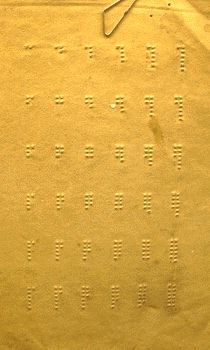The Barbier Alphabet
Night Writing or
Sonographie by the French
artillery captain
Charles Barbier
The purpose of the "night writing" by Charles Barbier de La Serre (in french), invented around 1815 for
military use, was to be able to transmit troop commands in darkness, without betraying
one's own position. They should be written and read without lighting a light.
His tactile signs each consisted of two vertical rows of one to six dots, which
were pressed into paper by means of a simple device. Reading was
done by turning the sheet around and feeling the raised dots.

Barbier experimented with a three, eleven and twelve dot system. In the
twelve-dot system, his later Night Writing (Ecriture Nocturne), the
possible 36 characters were assigned to French sounds.


---------- Table Barbier Alphabet: ----------
Numbers behind the d in parentheses are occupied dots
according to the following scheme (left column) (right column):
Line 1: [1] [1]
Line 2: [2] [2]
Line 3: [3] [3]
Line 4: [4] [4]
Line 5: [5] [5]
Line 6: [6] [6]
Sound 'a' = d1 + d1
Sound 'i' = d1 + d12
Sound 'o' = d1 + d123
Sound 'u' = d1 + d1234
Sound 'é' = d1 + d12345
Sound 'č' = d1 + d123456
Sound 'an' = d12 + d1
Sound 'in' = d12 + d12
Sound 'on' = d12 + d123
Sound 'un' = d12 + d1234
Sound 'eu' = d12 + d12345
Sound 'ou' = d12 + d123456
Sound 'b' = d123 + d1
Sound 'd' = d123 + d12
Sound 'g' = d123 + d123
Sound 'j' = d123 + d1234
Sound 'v' = d123 + d12345
Sound 'z' = d123 + d123456
Sound 'p' = d1234 + d1
Sound 't' = d1234 + d12
Sound 'q' = d1234 + d123
Sound 'ch' = d1234 + d1234
Sound 'f' = d1234 + d12345
Sound 's' = d1234 + d123456
Sound 'l' = d12345 + d1
Sound 'm' = d12345 + d12
Sound 'n' = d12345 + d123
Sound 'r' = d12345 + d1234
Sound 'gn' = d12345 + d12345
Sound 'll' = d12345 + d123456
Sound 'oi' = d123456 + d1
Sound 'oin' = d123456 + d12
Sound 'ian' = d123456 + d123
Sound 'ien' = d123456 + d1234
Sound 'ion' = d123456 + d12345
Sound 'ieu' = d123456 + d123456
------------- End of Barbier Alphabet ---------------
to the top
|
die
print version of Barbier Alphabet
[
text version of Barbier Alphabets (new window) ]
How did Barbier come to this writing?
He developed it from the then usual way to encrypt messages using
a table. The 36 possible sounds corresponded to two digits each
(1st digit horizontal = line, 2nd digit vertical = column). Due to
the strong reduction to only 36 sounds, the language
could only be reproduced inaccurately, hence
the name sonography (sound font).

The complete French alphabet includes with umlauts to the
43 letters, the French notation is very complicated.
Hence the idea with the phonetics.
1.) Transformation of the text into numbers (encode)

2.) Representation of the numbers as tactile dots

But since no light could be used to read and write his
Night Writing, the coding table had to be memorized. Added
to the problem of used phonetic transcription was the practical
difficulty: that the sometimes long rows of dots with the fingers were
difficult to detect. Because of that, his idea under military conditions was not
practical, making the Night Writing of Charles Barbier never gained importance.

Still convinced of the value of his Night Writing, Charles Barbier submitted it to the Institute
for the Blind in Paris in 1819 and 1820, which brought the young Louis Braille in contact
with it and further developed it for himself. He replaced the sounds with letters and
reduced the up to 12 dots to the known six. As a result, Braille's blind writing
was quickly learned by the blind and could also prevail internationally.
Another advantage of Braille Alphabet over Barbier's Night Writing
was the ability to display numbers and punctuation marks.
That did not play any role in encrypting messages, but
for use in mathematics or high-level literature.
Braille  Alphabet
Alphabet
But not only Louis Braille was inspired by the Night Writing of Charles Barbier. Alexander
Fakoó also developed his Fakoo Writing out of the idea of creating a dot writing for
blind and sighted people with only 12 dots, but in a grid of 3 × 4 dots. By further
attempts the number of dots could then be reduced to 9 dots (see Fakoo).

Direct comparison of the writings
Barbier, Fakoo and Moon:








 Alphabet
Alphabet


